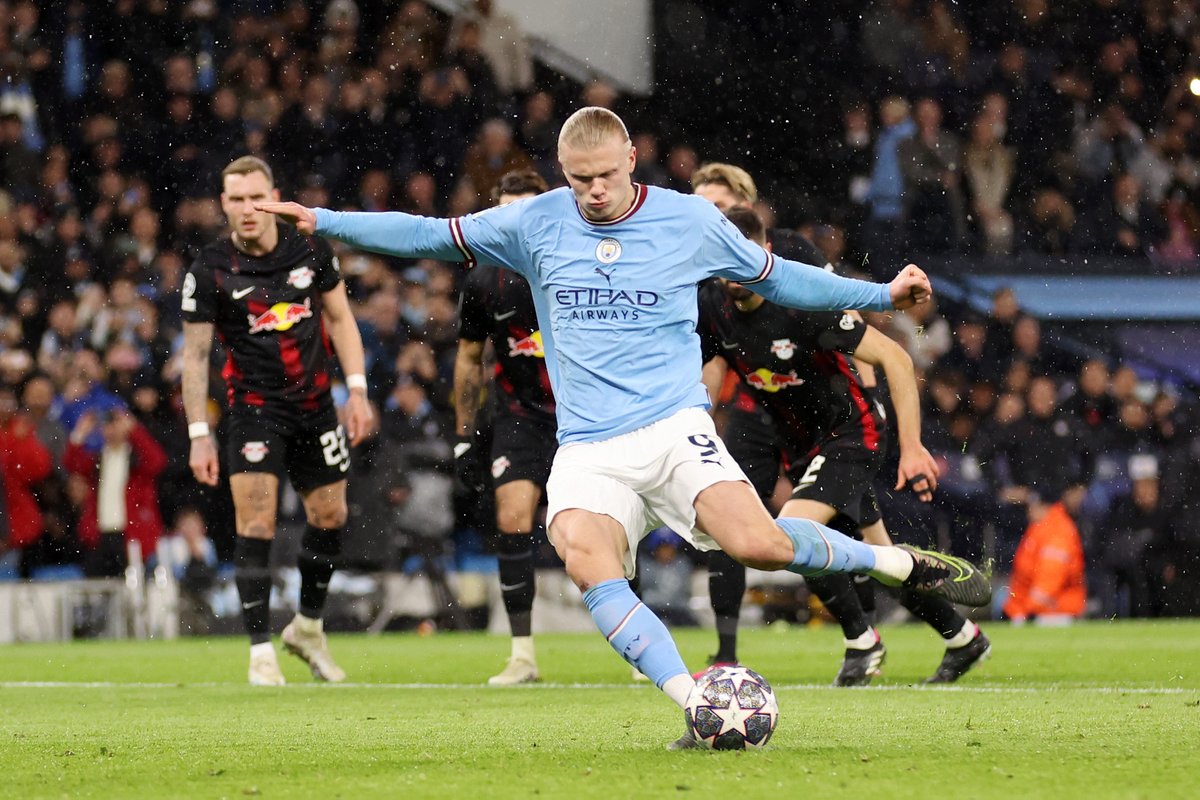Erling Haaland would finish the Premier League season with 39 goals if he maintains his current strike-rate and playing time, and 41 goals if he played every minute of every game.
The Norwegian is on pace to brҽak the Premier League record of 34 Golden Boots held by Andy Cole (1993/94) and Alan Shearer (1994/95), both of whom accomplished the feat in 42-game seasons.

If he maintains his ratios and reaches the finals in all remaining club contests, Haaland would score 60 goals in all competitions this season, or 66 if he was never substituted.
The 22-year-old had scored only twice in eight games prior to late January, but he regained his astounding ratios with a penalty against Crystal Palace, five goals against RB Leipzig, and a hat-trick against Burnley in the FA Cup.

The striker was scheduled to join the Norway national team this past week, but he withdrew after suffering a groin injury against the Clarets.
According to his father Alf-Inge, Haaland is now “touch and go” for Manchester City’s match against Liverpool on Saturday.
How does Haaland score goals, and how do his opponents defend against him?
The towering forward has scored 28 goals in just 26 Premier League games and has scored hat-tricks in nine of those contests, including victories over Crystal Palace, Nottingham Forest, Manchester United, and Wolves.

These statistics produce a league ratio of 1.19 goals per 90 minutes, which is more potent than any other player in Europe’s top five leagues who has played more than 504 minutes this season.
The graph below displays goals and expected-goal (xG) returns for all Premier League players this season and illustrates the striker’s dominance in both categories.

Other forwards from opposing clubs, including Alexander Isak, Harry Kane, and Ivan Toney, are in regular form, but Haaland’s statistics dwarf those of his competitors.
On the basis of the sheer number of clear-cut opportunities created by Pep Guardiola’s team, some critics may argue that any established striker would score a ton of goals for them.

Yet, the Norwegian has also outperformed his xG returns by nearly 50 percent, scoring eight goals more than the 20 projected from chances offered to him — an additional ratio that ranks first in the league.
In addition, Haaland has scored 28 goals on only 44 sɦots on goal, which implies that his current goal tally is equivalent to one goal for every 1.62 sɦots on goal, highlighting his clinical finishing to date.
Key to stopping Haaland?
The sɦot map demonstrates that the majority of City’s No. 9’s goals have been scored from within the six-yard box, with practically all goals coming from the center third of the opposing box.
Haaland has a near-perfect conversion rate while sɦooting to the left side of the goal, scoring on 16 of 20 sɦots on target, and scores on almost half of his tries in the center and to the right of the goal.

Haaland appears quite unstoppable when in full swing. His acrobatic and aerial talent, along with his physical height, strength, and speed, is resisting all attempts to negate his powers, despite the fact that his opponents are aware of his primary threɑt to the left of center.
All-around play
The gap between the number of goals he has scored and the number of goals he has assisted on demonstrates how he typically scores on the spot.

Yet, he averages significantly fewer touches, dribbles, and passes in the final third than other forwards, a shortcoming that City and the majority of clubs would gladly give for his prodigious strike rate.
Haaland had six touches in 45 minutes against Aston Villa in February and eight touches in 74 minutes against Bournemouth in August. Nonetheless, he presently averages 22.25 touches per goal, which translates to 4.5% of his total actions on the ball resulting in a goal.
In terms of passing, Haaland likes to drift and combine with teammates across the width of the penalty box, with a somewhat larger concentration of exchanges down left-centre areas — while he creates his most dɑngerous opportunities from central areas just outside the box.
Have changes been made to City to accommodate Haaland?
Despite Haaland’s blazing start at the Etihad, City have historically begun seasons slowly, and this season was no exception; yet, there are indications Guardiola’s squad has significantly altered their style.

Based on his minimal touches, the graph below depicts how Haaland averaged in a comparable position to the false nine last season. Kevin De Bruyne has gone upfield, the fullbacks have narrowed, and the left winger has expanded slightly.
Despite Haaland’s extraordinary rate of scoring, City’s output has reduced from 2.6 goals per game last season to 2.5 goals per game this season. Expected goals and sɦots on target are also declining, indicating that teammates are sɦooting less frequently.
Intriguingly, City are also attempting less crosses and through-balls per game this season, two statistics that many would anticipate to grow in order to accommodate and serve Haaland.
The striker is currently on pace to end the season with 66 goals in all competitions assuming he reaches every final and plays every minute of the regular season. In all likelihood, the Norwegian will brҽak other records, and there is a growing belief that he will rewrite the record books totally.
